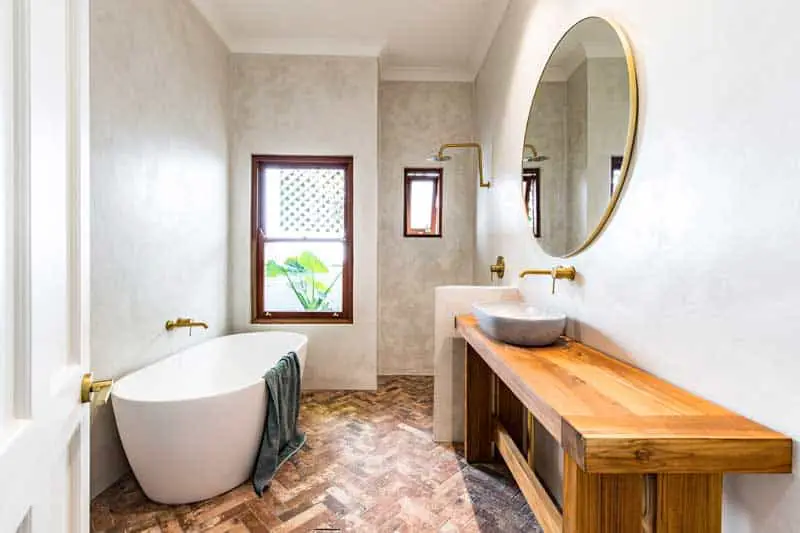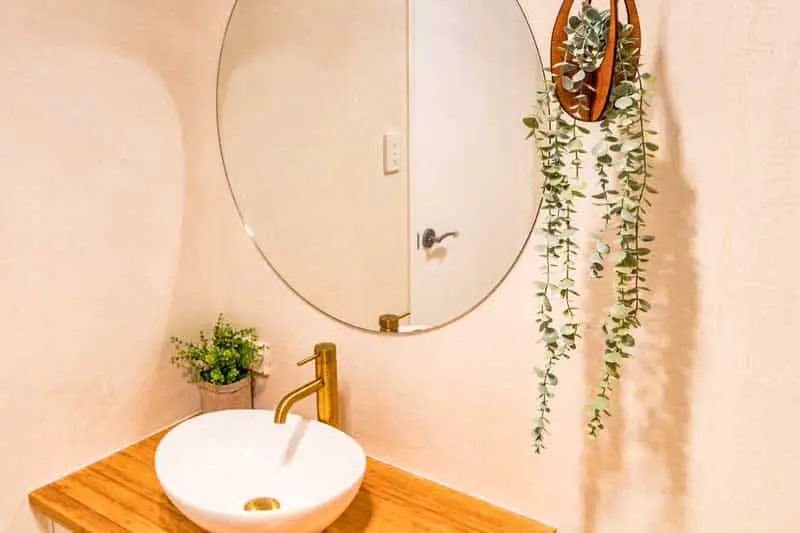
Lime plaster and other building materials are among the oldest in the world. They have been tried and tested for thousands of years. But it can still be tricky to understand where and when lime plasters should and shouldn’t be used. For instance, can lime plasters be used in bathrooms?
Generally speaking, lime plasters are very well suited to bathrooms. Lime plasters will help to control the humidity naturally. They will absorb moisture from the air when there is too much (while you’re showering, for example) and release it when the humidity is much lower. In addition, lime plasters are mildly anti-fungal and anti-bacterial due to their high alkalinity. This means lime plasters help create a stable, clean, comfortable bathroom environment.
What Makes Lime Plasters Suited For Bathrooms?
As you are probably aware, bathrooms can be particularly humid, especially on those cold winter evenings when you may turn the heat up. Lime plasters and most other lime-based building materials are breathable. This means air and moisture can pass through them, helping them to balance moisture levels in a building, unlike waterproof building materials like cement that can trap water behind them.
In bathrooms where waterproof materials are used, you may notice that the walls and ceiling are wet after showers and baths. This is because the steam and extra water cannot escape, so it condenses on the first cold surface it reaches. Whilst this isn’t itself bad or damaging to the building, it can be unsightly and lead to other issues. Mould growth is common in damp areas, and waterproof walls that become covered with water after every shower or bath are the perfect place for mould to thrive.

In contrast, lime plasters can absorb the excess water caused by showers and baths. This may initially make them appear damp, but the plasters release the water when humidity stabilises. This means your bathroom maintains a more comfortable environment when compared to waterproof materials.
Overall, using lime plasters for your bathroom will help reduce and eliminate condensation issues, leading to a far more comfortable space. This in itself will help to get rid of any mould or other unwanted microbes. Lime plasters are softer to the touch than cement or gypsum and have a far lower thermal conductivity. This means the plasters feel warm when it’s too cold, and when it’s too hot, they feel cool. I think lime plasters are the best for bathrooms because of these characteristics.
Related article: Can You Get a Smooth Finish With Lime Plaster?
Can Lime Plaster Be Used On Shower Walls?
Lime plaster can be used for shower walls. There are specific lime-based plasters that can be used on shower walls. These plasters are waterproof, so not all of the benefits mentioned above would be realised if the entire bathroom was plastered with them. Tadelakt and waterproof Venetian plasters are great for plastering shower walls.
Tadelakt is a waterproof lime-based plaster used heavily in Morrocan architecture. This plaster is versatile and used to make baths, sinks, water vessels, ceilings, roofs, and floors and for internal and external plastering. Tadelakt is treated with soap to make it waterproof and water-repellant, so it is not suitable for areas which need good breathability. Overall, it’s a great alternative to tiles or shower boarding.

Venetian plaster is a type of lime plaster—lime putty (fat lime) mixed with various aggregates. Venetian plaster is made with special aggregates such as marble dust. This creates a very fine and smooth plaster. Venetian plaster is well suited to bathrooms because of its breathability. If it is used for shower walls, it will need to be sealed as lots of water could damage it.
Of course, you can plaster your bathroom with lime plaster and then tile or shower board over areas that will get extremely wet, such as shower walls and splashbacks. This will allow you to have all of the benefits of lime plaster.#
Related article: Does Lime Plaster Help To Prevent Damp?
Does Lime Plaster Stop Mould?
Lime is a fantastic natural way of removing mould without harsh chemicals or bleaches. It dehydrates the mould, and as mould cannot grow without moisture, it will die. In addition, lime helps absorb any nasty odours caused by the mould. Lime plaster and all other lime building materials are a high PH (alkaline) which kills mould, bacteria and small pests.
Lime plaster also helps prevent mould growth by controlling the moisture within a building. Lime can prevent dampness which in turn prevents mould growth. Using limewash or lime paint on lime plaster will further reduce the possibility of mould growth. Regularly limewashing once or twice a year will help kill any mould that does manage to grow due to the high alkalinity.
How Long Will Lime Plaster Last For In A Bathroom?
Lime plaster and other lime building materials are very long-lasting. In most cases, they will outlast cement or more modern building materials. Lime plaster has been known to last for centuries and is still in good condition. Because lime plasters are breathable, they can regulate the humidity levels in your bathroom without damaging themselves or the substrate it has been applied to.
Regular limewashing of lime plaster in bathrooms is another fantastic way to help improve longevity. Over time, buildings move and flex. Because lime plaster is flexible, it can cope with this small movement. Over time, micro-cracks will likely appear. Limewashing the wall will help fill these cracks with ‘free lime’ in the limewash. This effectively self-heals the plaster and prevents more cracks from forming. Limewashing once a year will greatly extend the lifespan of lime plaster in a bathroom.
Related article: What Are The Best Paints For Lime Plaster?

